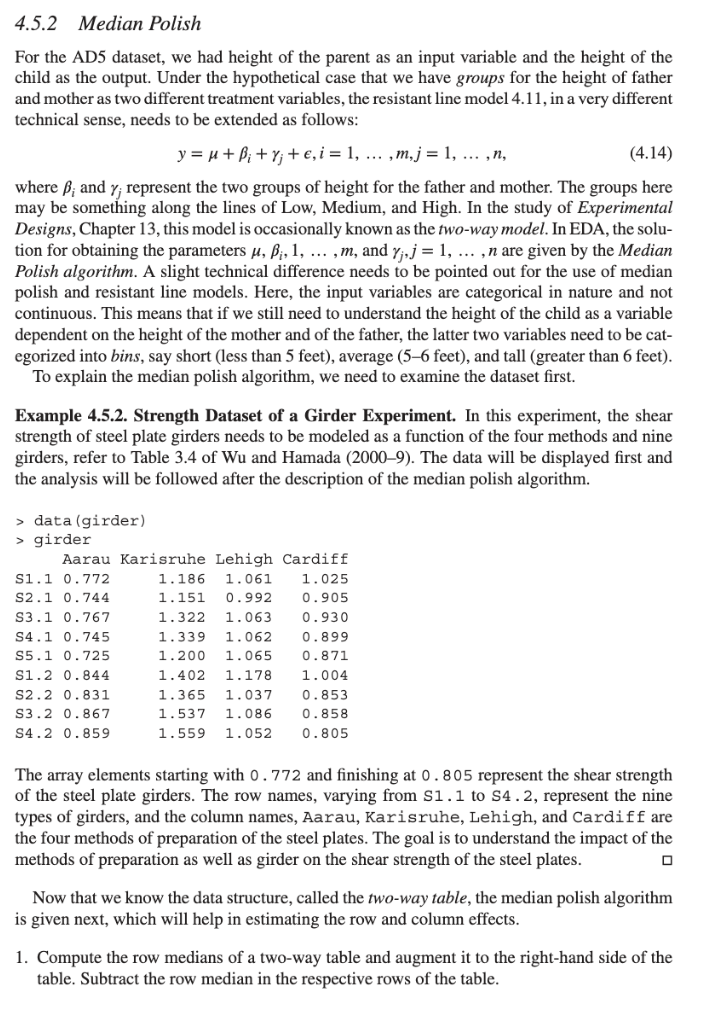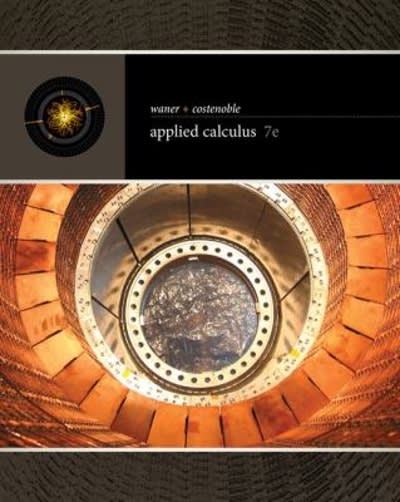4.5.2 Median Polish For the AD5 dataset, we had height of the parent as an input variable and the height of the child as the output. Under the hypothetical case that we have groups for the height of father and mother as two different treatment variables, the resistant line model 4.11, in a very different technical sense, needs to be extended as follows: y = H + Bit rite, i= 1, ... . m,j = 1, ... ,n, (4.14) where ; and y; represent the two groups of height for the father and mother. The groups here may be something along the lines of Low, Medium, and High. In the study of Experimental Designs, Chapter 13, this model is occasionally known as the two-way model. In EDA, the solu- tion for obtaining the parameters #, f;, 1, ... , m, and y;, j = 1, ... ,n are given by the Median Polish algorithm. A slight technical difference needs to be pointed out for the use of median polish and resistant line models. Here, the input variables are categorical in nature and not continuous. This means that if we still need to understand the height of the child as a variable dependent on the height of the mother and of the father, the latter two variables need to be cat- egorized into bins, say short (less than 5 feet), average (5-6 feet), and tall (greater than 6 feet). To explain the median polish algorithm, we need to examine the dataset first. Example 4.5.2. Strength Dataset of a Girder Experiment. In this experiment, the shear strength of steel plate girders needs to be modeled as a function of the four methods and nine girders, refer to Table 3.4 of Wu and Hamada (2000-9). The data will be displayed first and the analysis will be followed after the description of the median polish algorithm. > data (girder) > girder Aarau Karisruhe Lehigh Cardiff S1 . 1 0. 772 1. 186 1.061 1 . 025 $2 . 1 0 . 744 1 . 151 0. 992 0. 905 S3 . 1 0. 767 1. 322 1. 063 0. 930 $4 . 1 0 . 745 1.339 1 . 062 0 . 899 $5 . 1 0 . 725 1. 200 1. 065 0. 871 S1 . 2 0 . 844 1. 402 1. 178 1. 004 S2. 2 0. 831 1.365 1. 037 0. 853 S3 . 2 0. 867 1.537 1 . 086 0 . 858 S4 . 2 0. 859 1. 559 1.052 0 . 805 The array elements starting with 0 . 772 and finishing at 0 . 805 represent the shear strength of the steel plate girders. The row names, varying from S1 . 1 to $4 . 2, represent the nine types of girders, and the column names, Aarau, Karisruhe, Lehigh, and Cardiff are the four methods of preparation of the steel plates. The goal is to understand the impact of the methods of preparation as well as girder on the shear strength of the steel plates. Now that we know the data structure, called the two-way table, the median polish algorithm is given next, which will help in estimating the row and column effects. 1. Compute the row medians of a two-way table and augment it to the right-hand side of the table. Subtract the row median in the respective rows of the table.2. Take the median of the row medians as the initial total effect value of the row effect. Similar to the original elements of the table, subtract the initial total effect value from the row medians. 3. Compute the column medians of the original columns for the matrix in the previous step and append it to the bottom. Subtract from the data matrix the corresponding column medians. 4. Similar to Step 2, obtain the median of the column medians and add to the initial total effect value. Remove the current total effect median from each element of the column medians. 5. Repeat the four steps above until convergence of either the row or the column medians. The medpolish function from the MASS package can be used to fit the median polish model. This will be illustrated in a continuation of the girder experiment. Example 4.5.3. Strength Dataset of a Girder Experiment. Contd. The medpolish func- tion can be readily applied over the girder data frame. > medpolish (girder) 1: 1.96 2: 1. 701 Final: 1.686 Median Polish Results (Dataset: "girder2") Overall: 0.989 Row Effects: S1 . 1 $2 . 1 $3 . 2 S4 . 2 - 0. 005375 -0 . 053875 0 . 054625 0.033625 Column Effects: Aarau Karisruhe Lehigh Cardiff -0. 2116 0. 3330 0 . 0740 -0 . 0695 Residuals : Aarau Karisruhe Lehigh Cardiff S1. 1 0. 0000 -0. 1306 0.0034 0. 1109 $2. 1 0. 0205 -0. 1171 -0. 0171 0. 0394 S3. 1 -0. 0104 0. 0000 0.0000 0. 0105 $4. 1 -0. 0239 0. 0255 0. 0075 -0.0120 $5. 1 - 0. 0025 -0 . 0721 0. 0519 0 . 0014 S1. 2 - 0. 0179 - 0. 0045 0. 0305 0. 0000 $2. 2 0. 0451 0. 0345 -0.0345 -0. 0750 $3.2 0. 0350 0. 1604 -0.0316 -0.1161 S4 .2 0. 0480 0. 2034 -0.0446 -0.1481 The median polish solution shows that the Karisruhe method of preparation helps in cre- ating higher shear strength of the steel plates.Carry out the multiple hypothesis testing problem (use the glhtfundion from the multcomp package) for the median polish regression model fitted in Section 4.5.2









